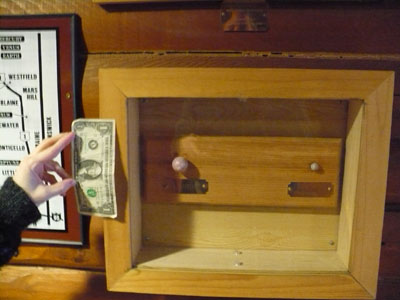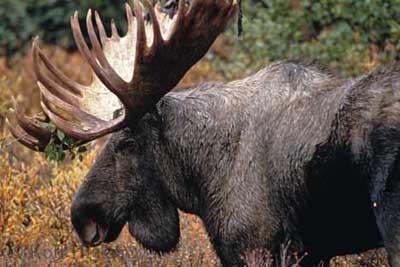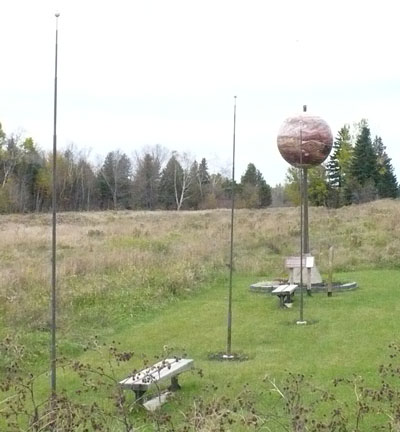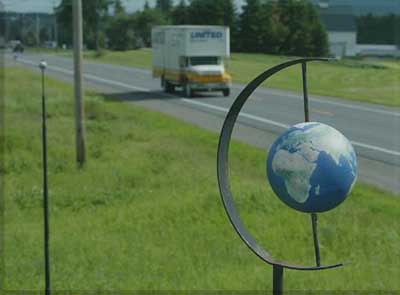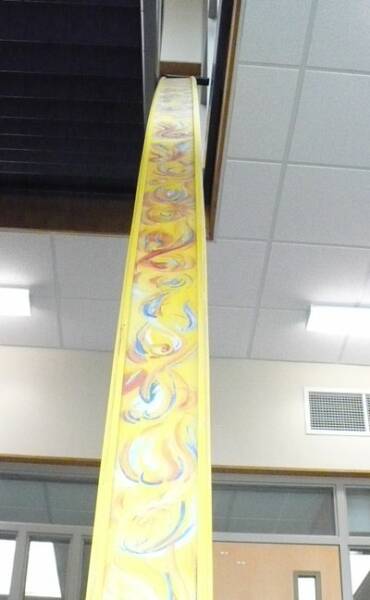"Klytus, I'm bored. What plaything can you offer me today?"
Ming the Merciless
The model is roughly 8 hours away from me by car, placing it squarely in the category of things-not-worth-driving-to-see- unless-I'm-in-the-area. But this year my lady Jennifer and I took a road trip to Nova Scotia and knew we would have to see the model on the way back. We had taken our telescope up to Cape Breton in hopes of doing some stargazing in that dark northern territory, but a relentless veil of cloud cover dashed those hopes. We needed some consolation to fill the void, as it were.
About a mile over the border from New Brunswick we found the Maine Welcome Center, where there was info on the model, as well as Pluto and Charon. These two bodies reside in an unassuming wooden frame in the hallway between the Visitor Center and the Mens Room.
As the model is built to scale in both relative distance and size, Pluto (which I still consider a planet) is quite small.
It was getting late, so we grabbed a copy of the brochure about the model and struck north.
And saw nothing.
We learned quite quickly that the planets are not lit, and that their signage is a dark brown. Beside that, the mileage given on the brochure about the model seemed a bit off. Or perhaps my odometer was. We found Neptune in the fading light, saw no hint of Uranus, and got as far as Saturn before full night fell. The ringed planet was clearly visible in the dark, but almost impossible to photograph.
I decided to give up. Even if we had made it to the museum, we had no guarantee that it would be open. The museum resides in the hallways of the university itself and there was no way to know if there were night classes or not.
I resigned myself to skipping the model altogether. We had other things to do in Maine over the next few days, and I wanted to get some miles behind us before we called it a night.
It was at this point, travelling south along Route 1 at a fair clip, that we nearly struck a moose sitting unseen by the side of the road.
We decided then and there to not brave the unlit highways of northern Maine. Who knew what other colossal creatures lay waiting in the blackness between the worlds...
We procured a hotel room in Houlton.
Conquering the Solar System was now a personal mission. I would stride the cosmos, the planets falling beneath my Reeboked feet.
The next morning we ate breakfast and began in earnest.
The first world we encountered was another Pluto. Situated on the edge of an expansive farm, this one had been erected to mark the average point of its orbit, while the one 7 miles behind us at the Visitor Center signified its apogee. Dark thoughts of re-labeling one of them as Yuggoth flashed in my head.
It should be noted that at this scale one mile equals one AU, and the speed of light is 7 MPH. A brisk walk becomes relativistic, incurring sizable time dialation. Even the lowest speed limit is several magnitudes into the transluminal. It is also staggering to realize that Alpha Centauri would be about as far as the moon.
Less than a mile from the second Pluto, the bright blue sphere of Neptune was clearly visible in the distance. It sits at the edge of the woods eight miles into the journey.
The gap between Neptune and Uranus is the largest in the model at just under 12 miles, approaching a third of the model's total length. There is nothing between these two worlds except produce stands and the occasional church. The vast emptiness could drive a man to madness.
Uranus occupies the parking lot of a Grange Hall.
The brochure says that the moons of Uranus and Neptune are far too small at this scale to be rendered.
Before we started that morning I had wrestled with the most important question regarding this tour: what music to listen to.
It's roughy 80-90 minutes round-trip, not counting stopping for photos. An obvious choice would have been Holst's The Planets, but that probably would have made for poor driving music.
As it was I went with a Rush mix disk dominated by Cygnus X1 and Hemispheres, with a selection of Porcupine Tree songs for the trip back.
The first world with a moon included was Saturn, standing on a gravel apron by the side of the road with Titan.
I noticed that the planet was in less-than-pristine condition. The metal mesh that comprises the rings is a tad rusty, and there are a few small dents visible. An unfitting fate for the system's most eye-popping inhabitant.
Titan's presence made me happy. This little moon is probably second to Mars in the number of stories it has inspired.
Jupiter is a striking image. Visible from half a mile away, it dominates a small grassy field, the cyclopian red spot gazing out over the road.
It should be mentioned that each of these planets was hand-painted.
The Ganymean moons of Io, Europa, Callisto, and Ganymede stand in a row beside it. I started visualizing the trajectories of the Discovery and Leonov from 2010, then realized it's already 2008 and this is the closest we've come to Jovian orbit.
I also thought about the gas giant's gravitational influence, given the distances involved, and wished such a phenomenon could be conveyed in the model. We had visited the Magnetic Hill in New Brunswick, an illusion where your car appears to roll uphill in neutral. Such a gimmick would be fitting for Jupiter.
Onward we went. I fancied my trusty red Chevy joining the ranks of Rama, Thistledown, the Whale Probe, and other artifacts cruising through the solar system.
According to the brochure there is a model of Ceres to represent the asteroid belt, but we could not find it and suspect it has not been erected yet. However, the space between Jupiter and Mars is populated by a number of potato stands. Given the shape and sheer number of the spuds, I found that to be a far better representation.
Journeying deeper into the inner system, the planets lay far closer together. Mars stands sentinel to the border of Presque Isle itself. The world where J'onn J'onzz was born, John Carter wooed Dejah Thoris, and Doctor Manhattan went soul-searching, is a fist-sized orb nearly eclipsed by greetings from the Elks Lodge and Knights of Columbus.
In our current politically sensitive climate some might find it offensive that this model gives recognition to a world that has repeatedly attacked and invaded the Earth, but omitting it would be an insult to the brave men and women who defended us.
The Earth and Moon are a mere quarter-mile away, near a copse of trees. Leaves fell around them unhindered by Lagrange points.
And somewhere near the northeast edge of the North American continent painted on the surface, I imagined an atomic-scale race erecting a model of the planets, hoping that a fleck of gravel flung from the road would not bring about an extinction event.
It was about here in the journey that I formed the theory that local teenagers must have some ritual about copulating beneath each planet, some kind of "nine planets" club. I was also struck by the lack of vandalism. No world was defaced, but I wondered if somewhere a cadre of Velikovsky-devotees were planning to abscond with Venus.
It wouldn't be too hard. The softball-sized Venus hangs beside the Budget Travelers Motor Inn in the corner of the parking lot.
My train of thought continued. Did astrology buffs find this static syzygy of planets a mockery of their beliefs? The model did not convey the cryptic influences of the heavens. This Venus would never go retrograde at crucial junctures in one's life. There would be no transits, conjunctions, or occultations to auger the future. If astrology believers were as vocal as some groups in this country, they would demand that the aspects of human personalities influenced by each planet be listed along with their mass, orbital velocities, and distance from the Sun.
Mercury looms above a small garden near a car dealership across the street from the university.
Like Icarus, we were coming in close to the Sun. In the Star Trek universe we could accelerate towards it and slingshot ourselves into the past, but being in this rustic territory gave us that feeling already.
The Sun itself is unfortunately not a massive yellow sphere, but is instead represented by an arched painted beam that reaches three stories tall.
Conquering the Solar System is difficult work. There's no convenient place to get coffee. The only available rest rooms are at the university itself, and these parts get cold and windy in early October. By the end of the trip I found myself resembling Landru, Exeter, Rotwang or some other manic science fiction character.
Perhaps that is fitting, since now that I've seen this model, I want to visit the one in Sweden which measures 110 miles across, and the even larger one in Jordell Bank. I am now possessed by a lust for solar systems.
I do not know if this is the first inkling of cosmic villainy, but I certainly feel a sense of moderate accomplishment, albeit one redeemable only in Geek Cred.



